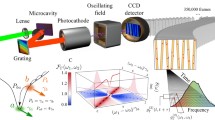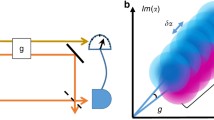Abstract
An entangled pair of photons (1 and 2) are emitted in opposite directions. A narrow slit is placed in the path of photon 1 to provide the precise knowledge of its position on the y-axis and this also determines the precise y-position of its twin, photon 2, due to quantum entanglement. Is photon 2 going to experience a greater uncertainty in momentum, that is, a greater Δpy because of the precise knowledge of its position y? The experimental data show Δy Δ py < h for photon 2. Can this recent realization of the thought experiment of Karl Popper signal a violation of the uncertainty principle?
Similar content being viewed by others
REFERENCES
K. R. Popper, “Zur Kritik der Ungenauigkeitsrelationen”, Naturwissenschaften 22, 807 (1934); K. R. Popper, Quantum Theory and the Schism in Physics (Hutchinson, London, 1983). Amongst the most notable opponents to the “Copenhagen School” were Einstein Podolsky Rosen, de Broglie, Landé, and Karl Popper. One may not agree with Popper's philosophy (EPR classical reality as well) but once again, Popper's thought experiment brings yet attention to the fundamental problems of quantum theory.
A. Einstein, B. Podolsky, and N. Rosen, Phys. Rev. 47, 777 (1935).
D. N. Klyshko, Photon and Nonlinear Optics (Gordon & Breach, New York, 1988).
A. Yariv, Quantum Electronics (Wiley, New York, 1989).
T. B. Pittman, Y. H. Shih, D. V. Strekalov, and A. V. Sergienko, Phys. Rev. A 52, R3429 (1995).
R. P. Feynman, The Feynman Lectures on Physics, Vol. III (Addison-Wesley, Reading, Massachusetts, 1965).
For criticisms of Popper's experiment, see for example, D. Bedford and F. Selleri, Lett. Nuovo Cimento 42, 325 (1985). M. J. Collett and R. Loudon, Nature 326, 671 (1987). A. Sudbery, Philosophy of Science 52, 470 (1985). A. Sudbery, in Microphysical Reality and Quantum Formalism, A. van der Merwe et al., eds. (Kluwer Academic, Dordrecht, 1988). Many of the criticisms concern the validity of a point source for entangled two-particles. However, a “point source” is not a necessary requirement for Popper's experiment. What is essential is to learn the precise knowledge of a particle's position through quantum entanglement. This is achieved in our experiment by means of a “ghost image”.
For discussions of the effect of the size of the source on one-particle and two-particle diffraction, see for example, M. Horne, Experimental Metaphysics, R. S. Cohen, M. Horne, and J. Stachel, eds. (Kluwer Academic, Dordrecht, 1997).
M. H. Rubin, D. N. Klyshko, and Y. H. Shih, Phys. Rev. A 50, 5122 (1994).
In type-I SPDC, signal and idler are both ordinary (or extraordinary) rays of the crystal; however, in type-II SPDC they are orthogonally polarized, i.e., one is ordinary and the other is extraordinary.
D. Bohm, Quantum Theory (Prentice Hall, New York, 1951).
E. Schrödinger, Naturwissenschaften 23, 807, 823, 844 (1935); translations appear in Quantum Theory and Measurement, J. A. Wheeler and W. H. Zurek, eds. (Princeton University Press, New York, 1983).
Y. H. Shih and A. V. Sergienko, Phys. Rev. A 50, 2564 (1994). A. V. Sergienko, Y. H. Shih, and M. H. Rubin, J. Opt. Soc. Am. B 12, 859 (1995).
Rights and permissions
About this article
Cite this article
Kim, YH., Shih, Y. Experimental Realization of Popper's Experiment: Violation of the Uncertainty Principle?. Foundations of Physics 29, 1849–1861 (1999). https://doi.org/10.1023/A:1018890316979
Issue Date:
DOI: https://doi.org/10.1023/A:1018890316979




